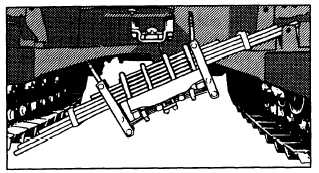l
l
l
l
l
Hard or rough ride
Sway on turns
Spring breakage
Sagging springs
Noises
The components of a suspension system are the
springs and shock absorbers. Some suspension systems
also have torsion bars.
SPRINGS
The springs support the frame and the body of the
vehicle as well as the load the vehicle carries. They
allow the wheels to withstand the shocks of uneven road
surfaces and provide a flexible connection between the
wheels and the body. The best spring absorbs road shock
rapidly and returns to its normal position slowly.
Extremely flexible or soft springs allow too much
movement of the vehicle superstructure, while stiff,
hard springs do not allow enough movement.
The springs do not support the weight of the wheels,
rims, tires, and axles. These parts make up the
“unsprung weight” of the vehicle. The unsprung weight
decreases the action of the springs and is, therefore, kept
to a minimum to permit the springs to support the
vehicle frame and load.
Multiple Leaf Springs
The multiple leaf spring is part of the front axle
suspension system, as shown in figure 3-5. It consists of
a number of steel strips or leaves of different lengths
fastened together by a bolt through the center. Each end
of the largest or master leaf is rolled into an eye which
serves as a means of attaching the spring to the spring
hanger and spring shackle. Leaf rebound clips surround
the leaves at two or more intervals along the spring to
keep them from separating on the rebound after the
spring has been depressed. The clips allow the spring
leaves to slide but prevent them from separating and
throwing the entire rebound stress on the master leaf.
The spring thus acts as a flexible beam. Leaf springs
may be suspended lengthwise (parallel to the frame) or
crosswise.
When a leaf spring is compressed, it must straighten
out or break; therefore, spring shackles are required at
one or both ends of the spring. Spring shackles provide
a swinging support and allow the spring to straighten out
when compressed. One shackle is used in either the front
or rear support of springs installed lengthwise. Two
shackles support springs installed crosswise. Figure 3-6
shows how a leaf spring is attached to a frame by a
spring shackle.
The most common types of spring shackles are the
link shackle and the U-shackle. Heavy vehicles have
link shackles. The U-type is more common on passenger
cars and light trucks.
On some wheeled tractors, link shackles support a
transverse spring on the dead front axle. Most wheeled
tractors do not even have springs, and all load
cushioning is through large, low-pressure tires.
Track tractors have one large leaf spring (fig. 3-7)
supported without spring shackles. Fastened to the
engine support, it rests on the frame supporting the
tracks and rollers. Brackets on the track frames keep the
spring from shifting.
Figure 3-6.-Cross section of a shackle link.
Figure 3-7.-Partially removed tracklayer spring.
3-5



